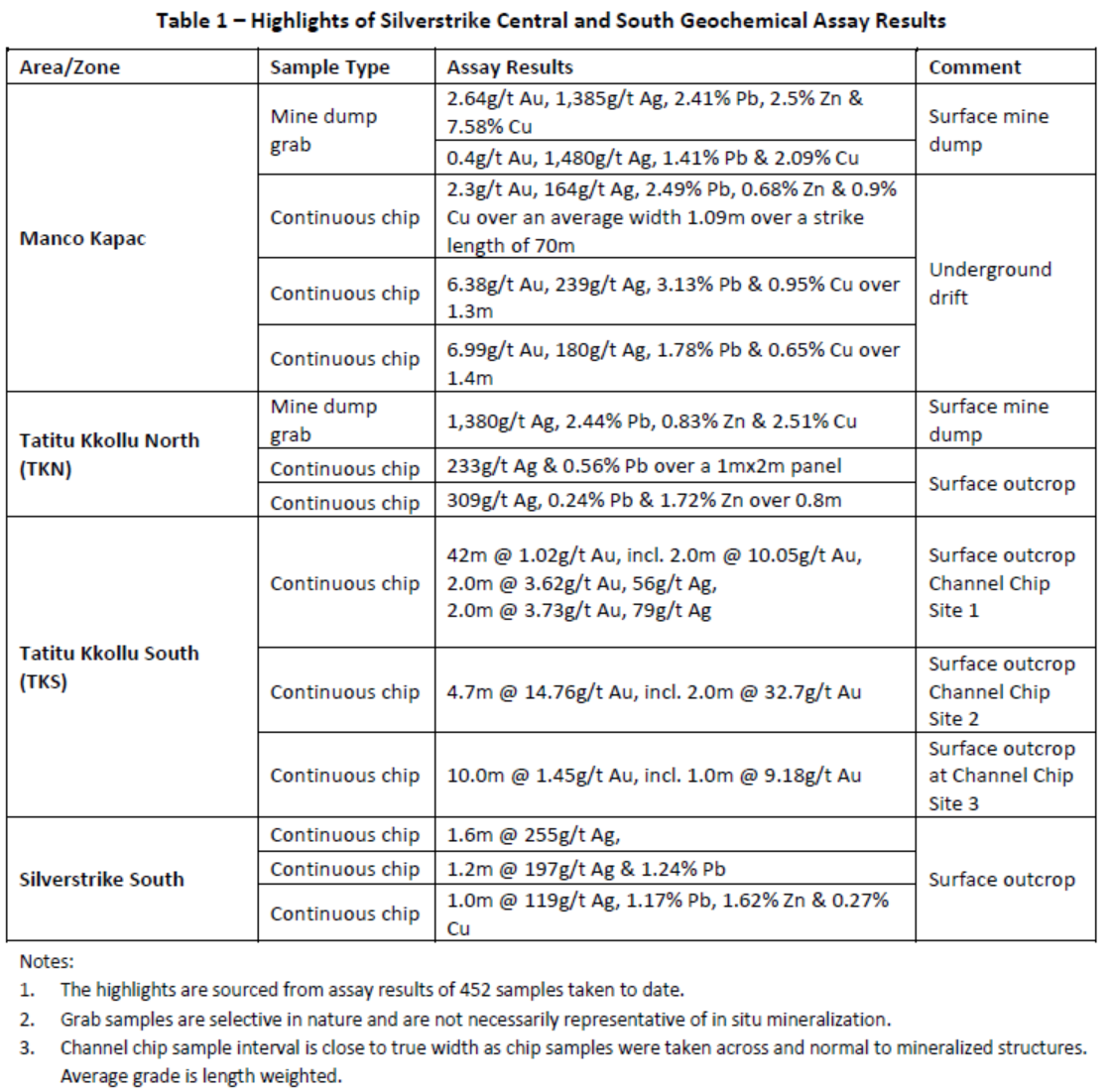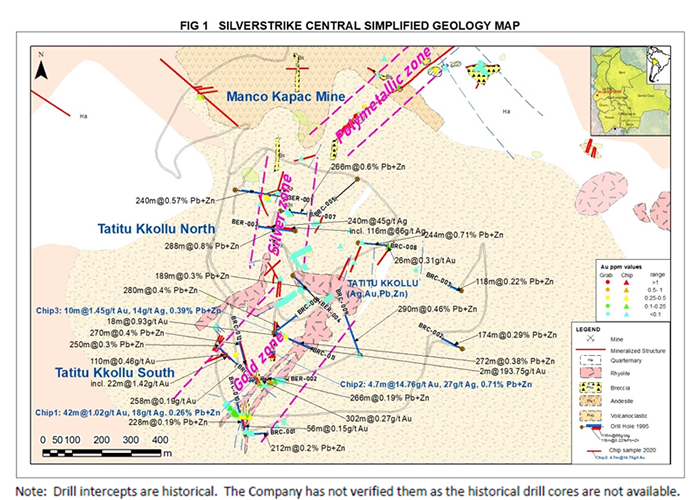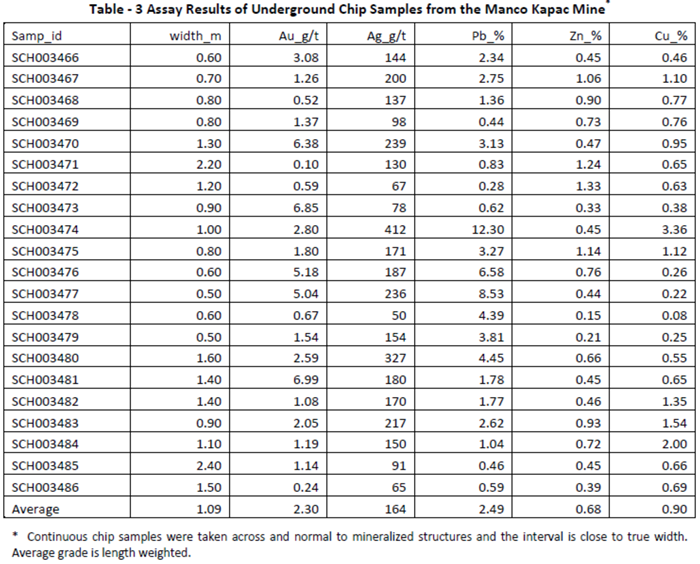Continuous Chip Samples Return 4.7 Metres Grading 14.76 Grams per Tonne Gold and 42 Metres Grading 1.02 Grams per Tonne Gold
VANCOUVER, British Columbia – November 19, 2020 – New Pacific Metals Corp. (“New Pacific” or the “Company”) is pleased to provide an update on exploration activities at the Silverstrike Project, Bolivia. Recent field work has focused on the Silverstrike Central and South areas where the Company has identified three significant new zones of gold and silver rich polymetallic mineralization – Table 1 and Figure 1. These areas, together with the previously released Silverstrike North zones, form high priority drill targets for testing once the required permits are obtained (see news release dated September 29, 2020 for details on Silverstrike North discovery).
BACKGROUND
The large Silverstrike property is comprised of three geologically distinct areas termed Silverstrike North, Central and South within which individual target zones occur (see news release dated December 4, 2019 for details). The current exploration program consists of 1:5,000 scale reconnaissance and 1:500 scale detailed geological, structural and alteration mapping and sampling of the Central and South areas. Highlights of assay results from the Central and South areas are provided in Table 1 and discussed below. A total of 452 samples were collected including 441 channel chip samples and 11 mine dump grab samples.
DISCUSSION
Silverstrike Central
Silverstrike Central is dominated by a ~900 metres (m) diameter volcanic dome – Cerro Tatitu Kkollu which consists of volcanoclastic sediments, hydrothermal breccias, rhyolite dyke swarms, and andesite flows (Figure 1).
Three significant areas of structurally controlled mineralization are geologically associated with the volcanic complex: Manco Kapac, Tatitu Kkollu North and Tatitu Kkollu South. Approximately 700m to the north of the dome silver-rich polymetallic mineralization was historically exploited at the former Manco Kapac mine. Centred on and immediately to the north of the dome, field work and previous drilling by Rio Tinto (in 1995) has identified broad zones of gold and silver-rich polymetallic mineralization hosted in hydrothermal breccias at Tatitu Kkollu North. Finally, gold mineralization has been defined at Tatitu Kkollu South at the contact zones between rhyolite dykes and their associated volcanoclastic sedimentary pile. See Table 1 for details.
The former Manco Kapac mine is characterized by mine dumps scattered along a NE trending corridor approximately 700m long and up to 200m wide (Figure 1). Exposure is comprised of intermittent outcrops of andesite and pyroclastics covered by recent alluvial sediments.
The distribution of the mine dumps suggest that multiple mineralized vein-breccia zones were mined in the past however, the majority of the former underground workings are not accessible. Mineralization is comprised of silicified vein breccia cemented by disseminated gold and silver rich polymetallic mineralization. Seven dump grab samples were collected returning average grades of 0.58g/t Au, 788g/t Ag, 6.07% Pb, 5.48% Zn, and 2.79% Cu (Table 2). A total of 49 channel chip samples were taken including 21 continuous chip samples from an accessible adit which returned an average grade of 2.3g/t Au, 164g/t Ag, 2.49% Pb, 0.68% Zn, and 0.9% Cu over an average width 1.09m and strike length of 70m (Table 3).
Tatitu Kkollu North is a silver rich zone associated with a NNE trending hydrothermal breccia estimated to be a minimum of 50m wide and 200m long based on the surface expression of the limited outcrop in the area (Figure 1).
A total of 61 samples (2 mine dumps and 59 channel chips) were collected. The two mine dump samples returned values of 1380g/t Ag, 2.44%Pb, 0.83% Zn and 2.51% Cu and 105g/t Ag, 0.69% Pb and 13.25% Zn respectively. Fifty-nine channel chip samples returned an average grade of 38g/t Ag, 0.11% Pb and 0.23% Zn with the highest sample reporting 309g/t Ag, 0.24% Pb and 1.72% Zn over 0.8m.
In general, the results are in line with historical drilling by Rio Tinto which returned 220m @ 45g/t Ag, 0.51% Pb and 0.44% Zn from 13.0m to 233.0m in hole BER-3, including a higher grade sub-interval of 116m @ 66g/t Ag, 0.81% Pb and 0.67% Zn from 13m to 129m downhole.
Gold-rich polymetallic mineralization at Tatitu Kkollu South occurs adjacent to the contact zones between volcanoclastic sediments and a NE trending rhyolite dyke swarm (Figure 1).
A single dump grab sample collected from a historic exploration adit returned 1.66g/t Au, 154g/t Ag, 0.69% Pb, 0.3% Zn, and 7.97% Cu. A total of 277 channel chip samples were collected over three key outcropping areas – Channel Chip Sites 1 to 3. Channel Chip Site 2 returned the best results and remains open for expansion (Figure 1 and Table 4):
Continuous mineralization of 42m @ 1.02g/t Au, 18g/t Ag, 0.15% Pb, and 0.11% Zn including 2.0m @ 10.05g/t Au, 30g/t Ag, 0.22% Pb, and 0.11% Zn was returned from Channel Chip Site-1, and 10m @ 1.45g/t, 14g/t Ag, 0.36% Pb including 1.0m @ 9.18g/t Au, 42g/t Ag and 0.74% Pb from Channel Chip Site-3. In addition to the composited intervals, isolated mineralized samples occur between lower grade or barren intervals beyond the continuous mineralized intervals at Channel Chip Sites 1 and 3.
Drilling by Rio Tinto in 1995 tested a small, near surface portion of the target zone returning broad intervals of Au mineralization:
· BER-02 – 302m @ 0.27 g/t Au within which 42m returned 0.52g/t Au.
· BRC-04 – 110m @ 0.46 g/t Au within which 22m returned 1.42 g/t Au.
· BRC-12 – 258m @ 0.19 g/t Au.
Based on the limited previous drilling by Rio Tinto and the latest sample results anomalous gold mineralization is intermittently traceable over an area of 700m long and up to 300m wide. Consequently, the Company interprets the Tatitu Kkollu South zone to represent an attractive near-surface bulk tonnage gold-rich target within which higher grade intervals may occur along strike and/or at depth.
Silverstrike South
At Silverstrike South, significant colonial-era mining dumps of the former Dos Amigos mine define an east-west trending mineralized zone approximately 350m long which is open on either end where it is covered by surface talus. In addition, currently active hydrothermal sinter and associated sediments indicate that the structure has remained active over a geologically prolonged period. The Company interprets this to be indicative of a metalliferous deep seated structural zone.
In detail, mineralization appears to be structurally controlled at the contact between a rhyolitic dome and Tertiary sediments. The width of mineralized system is unknown and the underground workings are not accessible. Twenty-one channel chip samples were collected predominantly from the partially exposed hanging and footwall to the mined structure, returning average grades of 49g/t Ag with the highest up to 255g/t Ag over 1.6m.
Given the extensive surface dumps and associated mining infrastructure including a small smelting house used to produce silver doré, it is possible that the historic Dos Amigo run of mine head-grades were higher than the grades of the recent chip samples.
FUTURE WORK
The Company is continuing to synthesize and fully interpret the data following which it will generate ranked drill targets for initial testing.
Quality Assurance and Quality Control
The grab and chip samples with results released in this news release were shipped in securely sealed bags by New Pacific staff in the Company’s vehicles directly from field to ALS Global in Oruro, Bolivia for preparation, and ALS Global in Lima, Peru for geochemical analysis. All samples are first analyzed by a multi-element ICP package (ALS code ME-MS41) with ore grade over limits for silver, lead and zinc further analyzed using ALS code OG46. Further silver over limits are analyzed by gravimetric analysis (ALS code of GRA21). Gold is analyzed by fire assay with AAS finish (ALS code Au-AA25).
The assay results of the grab and chip samples are used for reconnaissance purpose, hence no certified reference materials and blank materials were inserted to the normal sample sequence in the field. However, internal QAQC results of ALS lab did not show any significant bias of analysis or contamination during sample preparation.
Technical information contained in this news release has been reviewed and approved by Alex Zhang, P. Geo., Vice President of Exploration, who is a Qualified Person for the purposes of NI 43-101.
COMPLETION OF SPIN-OUT
The Company announces the successful completion of its previously announced spin-out of all common shares of Whitehorse Gold Corp. (“Whitehorse Gold”) held by the Company to Company shareholders effective November 18, 2020 by way of a share exchange under a court approved plan of arrangement (the “Arrangement”). More information about Whitehorse Gold and the Arrangement can be found in the Company’s management information circular dated August 27, 2020 and news releases dated July 22, August 26 and November 17, 2020, all of which are available for viewing on the Company’s SEDAR profile at www.sedar.com. Whitehorse Gold has received conditional approval from the TSX Venture Exchange (“TSXV”) for the listing of its common shares thereon.
ABOUT NEW PACIFIC
New Pacific is a Canadian exploration and development company which owns the Silver Sand Project, in the Potosi Department of Bolivia and the Silverstrike Project in Bolivia.
For further information, please contact:
New Pacific Metals Corp.
Gordon Neal
President
Phone: (604) 633-1368
Fax: (604) 669-9387
info@newpacificmetals.com
www.newpacificmetals.com
CAUTIONARY NOTE REGARDING FORWARD-LOOKING INFORMATION
Certain of the statements and information in this news release constitute “forward-looking statements” within the meaning of the United States Private Securities Litigation Reform Act of 1995 and “forward-looking information” within the meaning of applicable Canadian provincial securities laws. Any statements or information that express or involve discussions with respect to predictions, expectations, beliefs, plans, projections, objectives, assumptions or future events or performance (often, but not always, using words or phrases such as “expects”, “is expected”, “anticipates”, “believes”, “plans”, “projects”, “estimates”, “assumes”, “intends”, “strategies”, “targets”, “goals”, “forecasts”, “objectives”, “budgets”, “schedules”, “potential” or variations thereof or stating that certain actions, events or results “may”, “could”, “would”, “might” or “will” be taken, occur or be achieved, or the negative of any of these terms and similar expressions) are not statements of historical fact and may be forward-looking statements or information. Such statements include, but are not limited to: statements regarding anticipated exploration, drilling, development, construction, and other activities or achievements of the Company; timing of receipt of permits and regulatory approvals, including final TSXV approval of the spin-out and the listing of the Whitehorse Gold common shares on the TSXV; and estimates of the Company’s revenues and capital expenditures.
Forward-looking statements or information are subject to a variety of known and unknown risks, uncertainties and other factors that could cause actual events or results to differ from those reflected in the forward-looking statements or information, including, without limitation, risks relating to: global economic and social impact of COVID-19; fluctuating equity prices, bond prices, commodity prices; calculation of resources, reserves and mineralization, general economic conditions, foreign exchange risks, interest rate risk, foreign investment risk; loss of key personnel; conflicts of interest; dependence on management, uncertainties relating to the availability and costs of financing needed in the future, environmental risks, operations and political conditions, the regulatory environment in Bolivia and Canada, and other factors described under the heading “Risk Factors” in the Company’s Annual Information Form for the year ended June 30, 2020 and its other public filings.
This list is not exhaustive of the factors that may affect any of the Company’s forward-looking statements or information.
The forward-looking statements are necessarily based on a number of estimates, assumptions, beliefs, expectations and opinions of management as of the date of this news release that, while considered reasonable by management, are inherently subject to significant business, economic and competitive uncertainties and contingencies. These estimates, assumptions, beliefs, expectations and options include, but are not limited to, those related to the Company’s ability to carry on current and future operations, including: the duration and effects of COVID-19 on our operations and workforce; development and exploration activities; the timing, extent, duration and economic viability of such operations; the accuracy and reliability of estimates, projections, forecasts, studies and assessments; the Company’s ability to meet or achieve estimates, projections and forecasts; the stabilization of the political climate in Bolivia; the availability and cost of inputs; the price and market for outputs; foreign exchange rates; taxation levels; the timely receipt of necessary approvals or permits; the ability to meet current and future obligations; the ability to obtain timely financing on reasonable terms when required; the current and future social, economic and political conditions; and other assumptions and factors generally associated with the mining industry.
Although the forward-looking statements contained in this news release are based upon what management believes are reasonable assumptions, there can be no assurance that actual results will be consistent with these forward-looking statements. All forward-looking statements in this news release are qualified by these cautionary statements. Accordingly, readers should not place undue reliance on such statements. Other than specifically required by applicable laws, the Company is under no obligation and expressly disclaims any such obligation to update or alter the forward-looking statements whether as a result of new information, future events or otherwise except as may be required by law. These forward-looking statements are made as of the date of this news release.
CAUTIONARY NOTE TO US INVESTORS
The disclosure in this news release was prepared in accordance with Canadian National Instrument 43-101 (“NI 43-101”) and the Canadian Institute of Mining, Metallurgy and Petroleum Standards (the “CIM Definition Standards”) incorporated by reference therein, which differs significantly from the current requirements of the U.S. Securities and Exchange Commission (the “SEC”) set out in Industry Guide 7. Accordingly, such disclosure may not be comparable to similar information made public by companies that report in accordance with Industry Guide 7. In particular, this news release may refer to “mineral resources”, “measured mineral resources”, “indicated mineral resources” or “inferred mineral resources”. While these categories of mineralization are recognized and required by Canadian securities laws, they are not recognized by Industry Guide 7 and are not normally permitted to be disclosed in SEC filings by U.S. companies that are subject to Industry Guide 7. U.S. investors are cautioned not to assume that any part of a “mineral resource”, “measured mineral resource”, “indicated mineral resource”, or “inferred mineral resource” will ever be converted into a “reserve.” In addition, “reserves” reported by the Company under Canadian standards may not qualify as reserves under Industry Guide 7. Under Industry Guide 7, mineralization may not be classified as a “reserve” unless the mineralization can be economically and legally extracted or produced at the time the “reserve” determination is made. Accordingly, information contained or referenced in this news release containing descriptions of mineral deposits may not be comparable to similar information made public by U.S. companies subject to the United States federal securities laws and the rules and regulations thereunder. “Inferred mineral resources” are that part of a mineral resource for which quantity and grade or quality are estimated on the basis of limited geological evidence and sampling. Such geological evidence is sufficient to imply but not verify geological and grade or quality continuity. However, it is reasonably expected that the majority of inferred mineral resources could be upgraded to indicated mineral resources with continued exploration. Readers are cautioned not to assume that all or any part of an inferred mineral resource is economically or legally mineable. Further, while NI 43-101 permits companies to disclose economic projections contained in preliminary economic assessments and pre-feasibility studies, which are not based on “reserves”, U.S. companies have not generally been permitted under Industry Guide 7 to disclose economic projections for a mineral property in their SEC filings prior to the establishment of “reserves”. Disclosure of “contained ounces” in a resource is permitted disclosure under Canadian reporting standards; however, Industry Guide 7 normally only permits issuers to report mineralization that does not constitute “reserves” by Industry Guide 7 standards as in-place tonnage and grade without reference to unit measures. Historical results or feasibility models presented herein are not guarantees or expectations of future performance.
The SEC adopted new mining disclosure rules under subpart 1300 of Regulation S-K of the U.S. Securities Act (the “SEC Modernization Rules”) effective February 25, 2019, with compliance required for the first fiscal year beginning on or after January 1, 2021. The SEC Modernization Rules replace the historical property disclosure requirements included in SEC Industry Guide 7. As a result of the adoption of the SEC Modernization Rules, the SEC now recognizes estimates of “Measured Mineral Resources”, “Indicated Mineral Resources” and “Inferred Mineral Resources”. In addition, the SEC has amended its definitions of “Proven Mineral Reserves” and “Probable Mineral Reserves” to be substantially similar to corresponding definitions under the CIM Definition Standards. During the period leading up to the compliance date of the SEC Modernization Rules, information regarding minimal resources or reserves contained or referenced in this news release may not be comparable to similar information made public by companies that report according to U.S. standards. While the SEC Modernization Rules are expected to be “substantially similar” to the CIM Definitions standards, readers are cautioned that there are differences between the SEC Modernization Rules and the CIM Definitions Standards.





